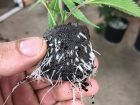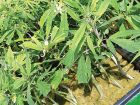
Features
Cultivation
Production
Good management practices for growing quality seedlings
September 3, 2019 By Mohyuddin Mirza
 In this picture, a commercial soilless growing medium is being used. These trays were directly seeded.
In this picture, a commercial soilless growing medium is being used. These trays were directly seeded.
You may call it a clone, a seedling or a transplant, these are the foundation of your business. I wanted to call it the “best management practices” but realized that growers have their own practices which they believe are the best. I just want to present information on how to grow good quality seedlings. I am finding that some seedlings are not of good quality and the result is that poor plants are being produced. I regularly look at clones being brought in and find insects and diseases on them. Like any other crop, these problems will be there and we should know how to handle them.
Seed germination
If you are starting from seeds, then you must know about the quality of those seeds. I have seen some strains that have less than 50 per cent germination. If a certain number of plants are needed, then plan accordingly. Also, remember that male plants are to be discarded. So the final number of seeds will depend on the above-mentioned fact.
Pre-treatment of seeds
Seeds can be surface disinfected with disinfectants like hydrogen peroxide to help get rid of any microorganisms on the surface. One can use one to three per cent of 35 per cent hydrogen peroxide for 10 minutes, shake well and rinse with plain water. It is recommended to soak seeds for six to eight hours in pH 6 water with 100-200 ppm hydrogen peroxide. These pre-treatments help the seeds to absorb water uniformly. Any damaged seed or poor seed will float and can be discarded.
SELECTING THE GROWING MEDIUM
Choose a growing medium based on their water holding capacity, air porosity and a basic nutrient charge. Prefer a growing medium where “good” microbes are added like mycorrhizae or root protecting agents. At this time, I am finding that growers are using three types of germination mixes: peat-based commercial media, coco fibre and rockwool. Know the physical, chemical and microbiological characteristics of the growing media. Some growers germinate seeds in rockwool or similar cubes and then transfer them into a growing medium. It is preferred to thoroughly soak the growing medium with pH adjusted water. When dry seeds are placed in these trays, then they start imbibing water and start activating the enzymes needed to start the germination.
Media management
Keeping the media well watered is important at this stage. Water gently so that seeds are not dislodged. The growing medium should not be allowed to dry out. It takes a few days before roots are developed, so the seeds have to depend on what moisture is in the growing medium.
Some growers place plastic under the trays for overnight watering and this may result in a water-logged situation. Germinating seeds “hate” water-logged conditions because of oxygen depletion when water is stagnant.
It is very important to start monitoring pH and EC right from the start. Many commercial soilless growing media have added lime to counter the acidic pH of the peat moss. A minimum pH of 5.0 is guaranteed; however, lime takes time to react after wetting and raise the pH to the proper level. If the starting pH of the medium is 5.0 or less, add potassium bicarbonate to raise the pH to a starting level of around 6.0. Similarly, check the EC of the growing medium. That will provide good benchmark information for planning further nutrient management.
If using coco coir based growing media, make sure that they are triple washed. Check the EC for yourself because I have seen very high sodium levels in some cases. High sodium can affect seedling growth and development and seed may not even germinate properly.
If rockwool cubes are used for germination, make sure that it is properly washed. Seeds use the stored food in embryos to provide energy up to the development of cotyledon leaves. Start fertilizing with a complete nutrient solution at this stage. Use EC values of around 1.4 millimhos.
Rooting of cloned material
There is a tendency to use fairly long cuttings and many leaves are clipped off. These clones depend on the food stored in the leaves for root development. If the light intensity is over 200 micromoles per square metre, then a conflicting situation is created for these clones. The light triggers the opening of stomata and there are no roots to transport water to the leaves. That is why high humidity offers the least stress on the plants.
Avoid high light intensity for rooting clones and start nutrient supply the moment root primordia become visible. Nutrient deficient seedlings will result in poor quality plants. The plants may recover but the integrity of structure is compromised.
Diseases
Many pathogens are waiting for opportunities to attack these seedlings. Because the density and humidity are high, there is greater chance of developing both root and foliar diseases. A major root disease is the fungus Pythium which attacks root hair and affects water and nutrient uptake capacity. The first symptoms on leaves appear as if there is water shortage. The leaves become very dark bluish in color. This fungus likes low oxygen in root zone due to over watering or water-logged conditions.
Botrytis grey mold and powdery mildew can also develop on leaves. Botrytis mold develops where stems or leaves have been wounded. That is why I discourage the practice of clipping the leaves and removing leaves from the stem.
Insects
I have seen thrips and spider mites coming with the clones. The suppliers of these clones should be notified if they find these insects and the growers should always check the clones thoroughly. Very strict sanitation protocols must be observed and followed with these clones.
Dr. Mohyuddin Mirza Ph.D., P.Ag. is the chief scientist with the Cannabis Nature & Company, Edmonton and is an industry consultant. Contact him at drmirza@cannabisnature.ca
Print this page

